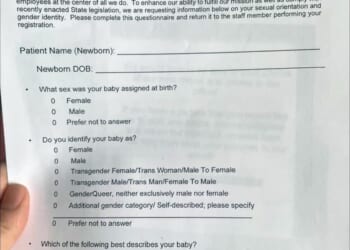Donald Trump’s whirlwind of action in the first seven weeks of his second term provokes mouth-agape admiration from the right and flat-footed bewilderment on the left.
From slashing 83 percent of USAID to transforming border crossings from firehose to garden sprinkler levels, it already feels as though the accomplishments in his first hundred days may surpass those of other presidents in their first thousand days. (RELATED: Illegal Immigration Is Down Under Trump — Can It Last?)
Then creeps an uneasy feeling. That birthed by presidential decree dies by presidential decree.
The case of Mahmoud Khalil serves as a cautionary tale to any who think that rule by the executive branch alone can effectuate lasting change.
Donald Trump’s Immigrations and Customs Enforcement over the weekend arrested Khalil — the noncitizen alleged leader of demonstrations, some of which appear quite illegal, at Columbia University — with the aim of deporting the Palestinian. On Monday, U.S. District Judge Jesse Furman, a Barack Obama appointee, blocked the deportation. (RELATED: The Arrest of Columbia University’s Mahmoud Khalil: Unmasking Campus Radicalism)
Judges more easily block executive action than legislation. Future presidents, as Donald Trump himself has shown in erasing Joe Biden’s executive orders, easily reverse presidential fiat.
Laws, passed by elected representatives and signed by presidents, prove quite difficult to repeal once enacted (see, Obamacare, the Interstate Commerce Act).
Consider the New Deal. Mainly achieved through legislation passed in 1933 and 1934, President Franklin Roosevelt’s program exerts a heavy influence in 2025.
Sure, the Supreme Court rightly ruled the harebrained Agricultural Adjustment Act and fascistic National Recovery Act unconstitutional, and the Second World War’s full employment effectively ended such popular programs as the Works Progress Administration and the Civilian Conservation Corps. But Social Security, the Tennessee Valley Authority, the Federal Housing Administration, and a few other of the New Deal alphabet-soup programs remain in 2025.
When does the Trump presidency’s whirlwind of legislation to accompany the whirlwind of executive action arrive?
President Trump does not enjoy huge majorities the way Roosevelt did upon taking office 92 years ago this month. But he sees majorities in both houses. They need not pass a new New Deal. They should enact a Big Repeal. Done legislatively, this stands a much greater chance of reducing Big Government — the lifeblood of the left as the Department of Government Efficiency (DOGE) exposure of USAID funds to various radical outfits demonstrates — than any DOGE decree. (RELATED: Foreign Aid Reform: USAID Has a History of Funding Terrorists and Anti-American Organizations)
Ronald Reagan stewarded legislation through Congress despite Democrats controlling the House. Bill Clinton similarly worked with Republican majorities through much of his presidency to pass meaningful laws and balance the budget.
Trump faces a better situation with regard to the House, the Senate, the courts, and even the media (which has discredited itself to an unsalvageable degree) than Republican presidents of recent memory. Despite what Rep. Al Green (D-Texas) insists, Trump did indeed receive an Election Day mandate. He needs to govern as though he does and not as though he faces a majority opposition in Congress. The clock ticks on his ability to institute substantive change through legislation, the one process essential to lasting policy transformation.
Milton and Rose Friedman wrote in the Tyranny of the Status Quo:
[A] new administration has some six to nine months in which to achieve major changes; if it does not seize the opportunity to act decisively during that period, it will not have another such opportunity. Further changes come slowly or not at all, and counterattacks develop against the initial changes. The temporarily routed political forces regroup, and they tend to mobilize everyone who was adversely affected by the changes, while the proponents of the changes tend to relax after their initial victories.
In many ways, Donald Trump Mach II gets this. Still, policy rarely lasts for decades when born of a president’s pen. Power shifts back and forth and never stays permanently with one faction. Senate Democrats who instituted the so-called “nuclear option” learned this the hard way. When Democrats retake the White House, Republicans will learn the pitfalls of relying on easily reversible (and easily established) orders to institute good policy. The road less traveled here involves convincing legislative majorities to embrace this or that good idea.
Bold action of the like the Trump Administration takes in these first two months deserves all the praise it receives. Uncoupled with the law that passes both houses of Congress, it should be seen as a fleeting rather than a forever victory.
READ MORE from Daniel J. Flynn:
The Best Predictor of Brat Behavior in Congress


![NYC Tourist Helicopter Falls into Hudson River, Siemens Executive and Family Among Those Killed [WATCH]](https://www.right2024.com/wp-content/uploads/2025/04/NYC-Tourist-Helicopter-Falls-into-Hudson-River-Siemens-Executive-and-350x250.jpg)






![Green Day’s Cringe Trump Diss Ends in Fire and Evacuation [WATCH]](https://www.right2024.com/wp-content/uploads/2025/04/Green-Days-Cringe-Trump-Diss-Ends-in-Fire-and-Evacuation-350x250.jpg)
![Red Sox Fan Makes the ‘Catch of the Day’ with Unconventional ‘Glove’ [WATCH]](https://www.right2024.com/wp-content/uploads/2025/04/Red-Sox-Fan-Makes-the-‘Catch-of-the-Day-with-350x250.jpg)
![Bikini Clad Spring Breakers Prove Our Education System is Failing Students [WATCH]](https://www.right2024.com/wp-content/uploads/2025/03/Bikini-Clad-Spring-Breakers-Prove-Our-Education-System-is-Failing-350x250.jpg)





